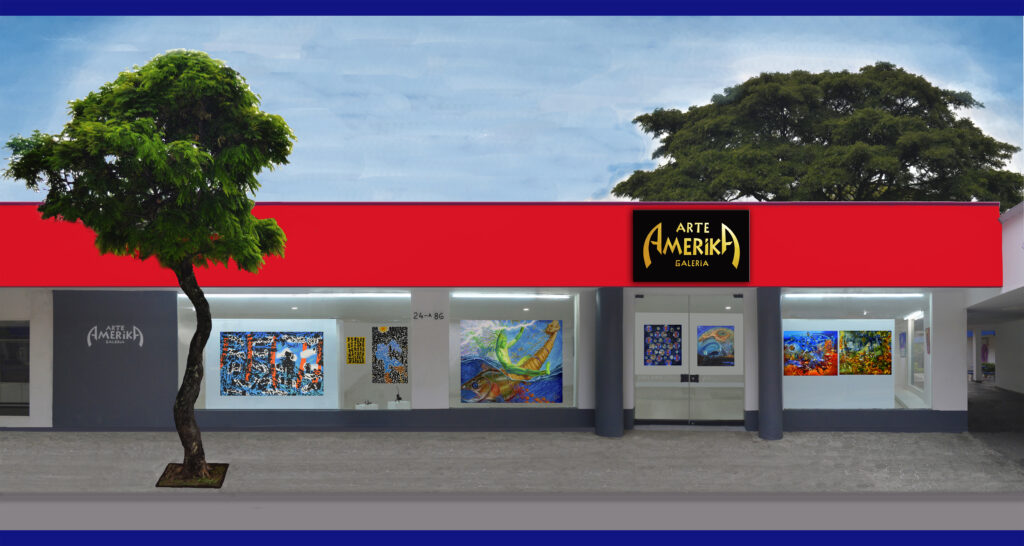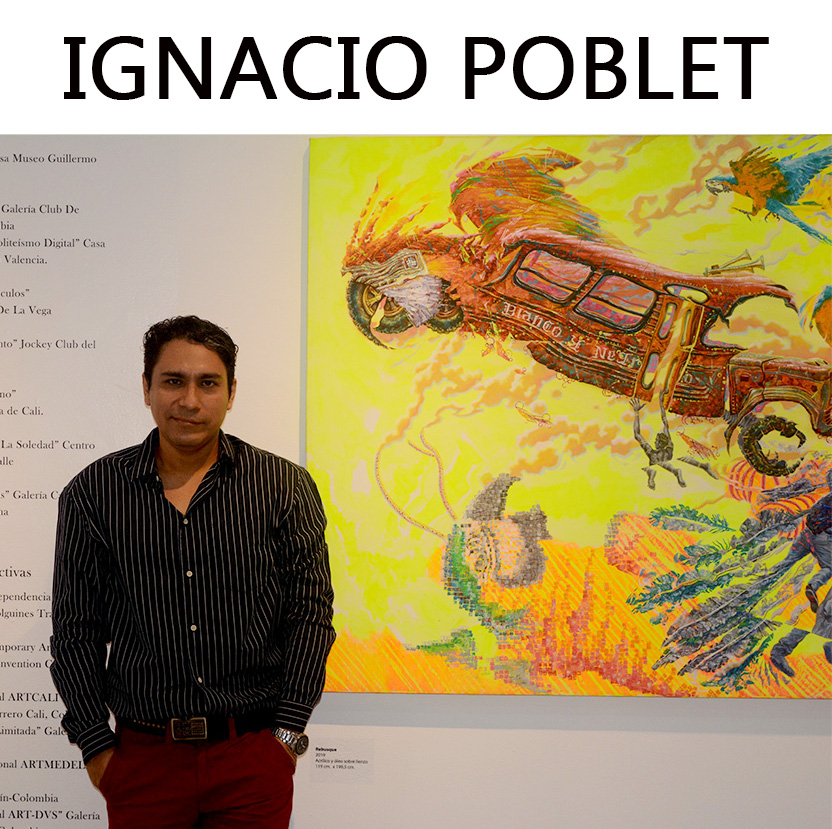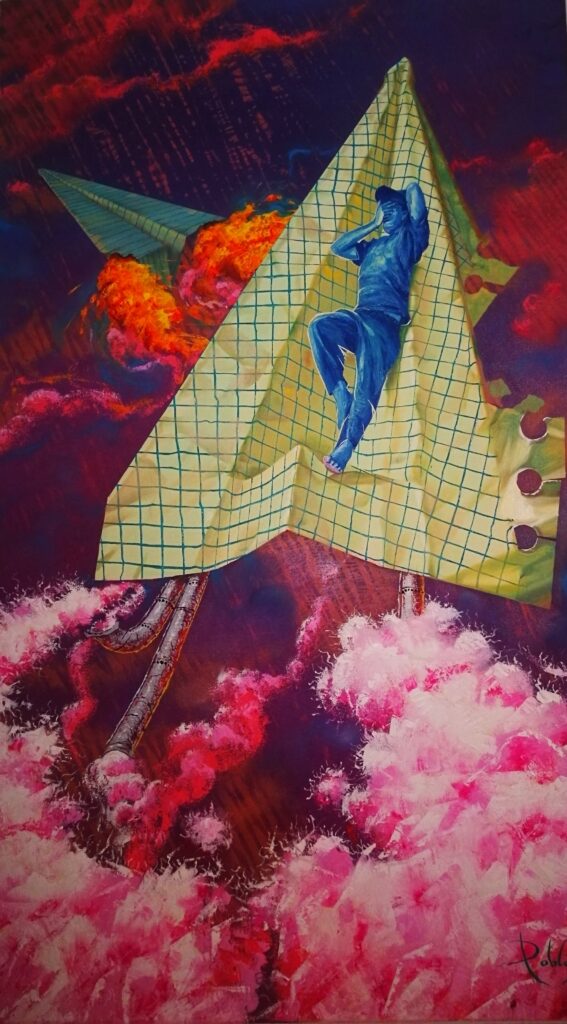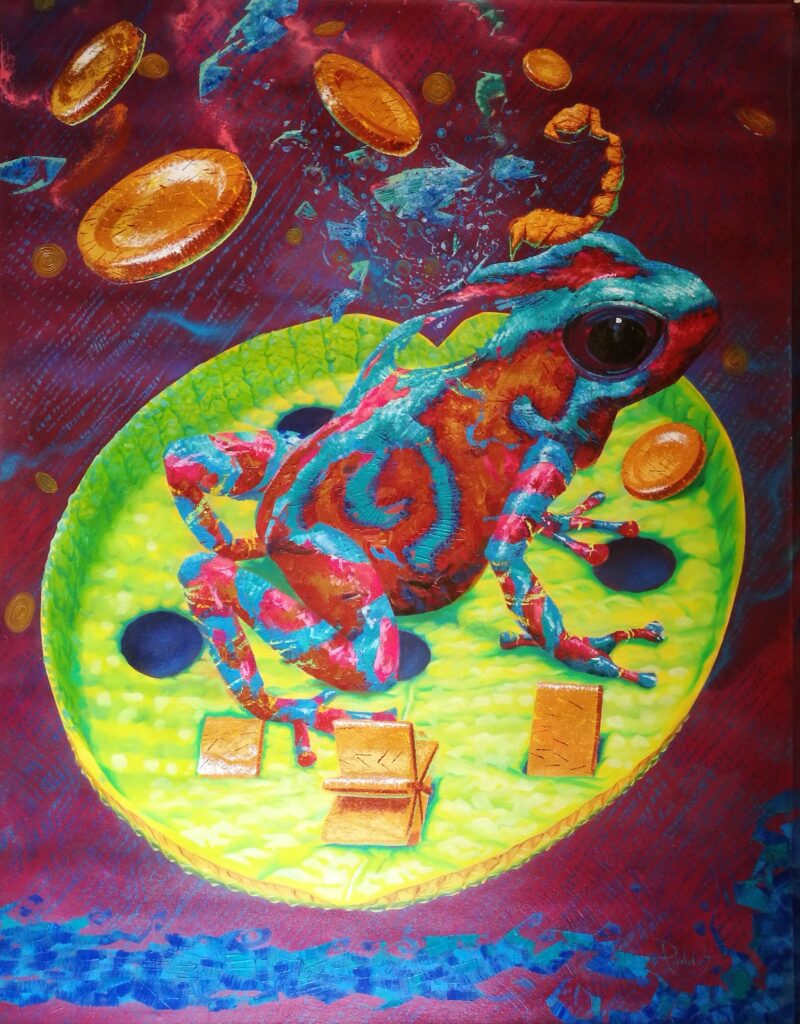






Las siguientes imágenes son pinturas realizadas por Ignacio Poblet , artista plástico nacido en Perú y formado en la “Escuela Nacional de Bellas Artes «de Lima, durante el periodo 1992 a 1997.
En su trayectoria de 25 años ha creado un estilo
artístico muy propio, que se ha consolidado
principalmente en Colombia.
The following images are paintings by Ignacio Poblet,
Peruvian-born plastic artist formed in the «National School of Fine Arts» in Lima city, from 1992 to 1997.
In his 25-year career he has created a style very own
artistic, which has been consolidated mainly in Colombia.
Les images suivantes sont des peintures réalisées par Ignacio Poblet , artiste plastique né au Pérou et formé à la «École Nationale des Beaux-Arts » de Lima, au cours de la période 1992-1997. Dans sa carrière de 25 ans a créé un style artistique très propre, qui s’est consolidé principalement en Colombie.

DESPLAZADO (Ancho: 164 cm. Alto 105 cm.)
Protagoniza la obra un papagayo que huye de un árbol-máquina metálico que emite humo por sus ramas. Sobre una de las ramas hay un tucán que se está convirtiendo en máquina y su pico es la parte de un automóvil. Otros pájaros en el árbol aún no han sufrido esta mutación. Es la maquinización del medio ambiente, donde todo debe ser industrializado para que produzca utilidades.
DISPLACED (Width: 164 cm. Height 105 cm.)
The main character is a parrot that runs away from a metal machine-tree that emits smoke through its branches. On one of the branches there is a toucan that is becoming a machine and its peak is the part of a car. Other birds in the tree have not yet undergone this mutation. It is

GAME OVER (SE TERMINÓ EL JUEGO) (Ancho: 109 cm. Alto: 174 cm.)
En esta obra protagonizada por una rana venenosa del amazonas, que está muy enojada, se plantea que la destrucción de la selva tropical es un juego que debe terminar. La rana está sentada sobre una caja de madera que representa un juego muy usual en Latinoamérica, y en vez de tener escrita en su parte frontal números de puntaje tiene lapidas de mármol que indican diversos daños ecológicos caudados a animales, plantas, ríos, y en general al ecosistema. Hay un equilibrio frágil que se indica al moverse en dos ruedas. También, al tener un tubo de escape que emite humo, muestra que el uso irracional de la máquina con la explotación excesiva, se genera un daño que es necesario corregir.
GAME OVER (Width: 109 cm. Height: 174 cm.)
In this artistic work, it is shown that a poisonous Amazon frog, who is very angry, it is proposed that the destruction of the rainforest is a game that must end. The frog is sitting on a wooden box that represents a very common game in Latin America, and instead of having scoring numbers written on its front it has marble slabs that indicate various ecological damage caused to animals, plants, rivers, and the ecosystem in general. There is a fragile balance indicated by moving on two wheels. Also, having an exhaust that emits smoke, shows that the irrational use of the machine with excessive exploitation, generates a damage that needs to be corrected.

DESERCIÓN DE LA CIUDAD (Largo: 70 cm. Ancho: 50 cm.)
En esta pintura está representado un automóvil Renault 4, que a su vez una tortuga. Este ser que está sufriendo una mutación, es mitad máquina y mitad animal. En el fondo está una ciudad sumergida, y en las profundidades aparece un pulpo que es totalmente máquina. Es una sutil critica a la supremacía de la máquina sobre la naturaleza, propio de la cultura actual. La tortuga «no quiere» convertirse en máquina y huye de la ciudad.
DESERTION FROM THE CITY (Width: 70 cm. Width: 50 cm.)
Represented in this image is a Renault car that is in turn a turtle. This being is half machine and half animal, it is undergoing a mutation. At the bottom is the submerged city and an octopus that is fully machine. It is a subtle criticism of the supremacy of the machine over nature, typical of today’s culture. The turtle does not want to become fully machine and flees the city.

EL CIELO ES EL LIMITE (Ancho: 70 cm. Altura: 120 cm.)
En esta obra se muestra un avión de papel que asciende con un personaje que se sorprende por el ascenso vertiginoso hacia arriba. Su título hace referencia a el éxito personal, donde la realidad que lo rodea le plantea que su ascenso será tan grande que “el cielo es el límite”. Es una paradoja entre la búsqueda del éxito y la posibilidad de no poder manejarlo adecuadamente, y quemarse en este ascenso, como le sucede al avión de papel que esta al fondo de la obra.
THE SKY IS THE LIMIT (Width: 70 cm. Height: 120 cm.)
This work shows a paper plane ascending with a character who is surprised by the dizzying ascent upwards. His title refers to personal success, where the reality surrounding him suggests that his ascent will be so great that «the sky is the limit». It is a paradox between the search for success and the possibility of not being able to handle it properly, and to burn in this ascent, as happens to the paper plane that is at the bottom of the work.

FRACKINGSTEIN (Ancho: 90 cm. Altura 90 cm.)
De nuevo, hay una crítica a la explotación de los recursos que pone en riesgo el medio ambiente, el término “Fracking” hace referencia al método de inyectar agua y químicos a los pozos petroleros para poder extraer hasta lo poco que les queda, y esta palabra se asocia al conocido personaje “Frankenstein”, como un monstruo construido por el hombre. Siendo el resultado final: “Frackingstein”, es decir el monstruo del fracking, que tiene avaricia por el petróleo, cueste lo que cueste.
FRACKINGSTEIN (Width: 90 cm. Height 90 cm.)
Again, there is a criticism of the exploitation of resources that puts the environment at risk, the term «Fracking» refers to the method of injecting water and chemicals into oil wells to be able to extract as little as they have left, and this word is associated with the well-known character «Frankenstein», as a monster built by man. Being the final

MONEY TALKS BUT I DONT MINE (El dinero habla, pero a mí no me importa)
(Ancho: 109 cm. Alto: 130 cm.)
Esta rana está indiferente ante las monedas que le están lanzando en una especie de juego que consiste en hacer entrar las monedas en unos huecos, o en la boca de la rana. Es una alusión al poder que ejerce el dinero hoy para comprar las conciencias y cambiar las convicciones de las personas. Esta rana es de fuertes convicciones y rehúsa abrir la boca para recibir este dinero, no se deja sobornar o comprar.
MONEY TALKS BUT I DONT MINE (Width: 109 cm. Height: 130 cm.)
This frog is indifferent to the coins that are being thrown at him in a kind of game that consists of making coins enter into holes, or into the mouth of the frog. It is an allusion to the power that money exercises today to buy consciences and change people’s convictions. This frog is of strong convictions and refuses to open his mouth to receive this money, he does not let himself be bribed or bought.

REALISMO MAGICO (Ancho: 105.5 cm. Alto: 130.5 cm.)
El titulo hace referencia a un género propio de la literatura latinoamericana llamado “Realismo Mágico”, donde la realidad se confunde con lo imaginario. En cierta manera, hoy en día persiste el antropomorfismo entre los animales y las máquinas. Muchas máquinas tienen semejanza a los animales. La obra se enfoca más a la imaginación y el juego de fusionar máquinas con animales, donde aún al ser humano se le atribuye características animales, como la fuerza del león, o la potencia de un elefante.
MAGIC REALISM (Width: 105.5 cm. Height: 130.5 cm.)
The title refers to a genre typical of Latin American literature called «Magical Realism», where reality is confused with the imaginary. In a way, anthropomorphism among animals and machines persists today. Many machines resemble animals. The work focuses more on the imagination and the game of fusing machines with animals, where even the human being is attributed animal characteristics, such as the strength of the lion, or the power of an elephant.
RÉALISME MAGIQUE (105.5 cm. largeur x 130.5 cm. haute) Le titre fait référence à un genre propre à la littérature latino-américaine l’appelé «Réalisme Magique», où la réalité se confond avec l’imaginaire. D’une certaine manière, de nos jours, l’anthropomorphisme persiste entre les animaux et les machines. Beaucoup de machines ont une similitude avec les animaux. L’œuvre se concentre par l’imagination et le jeu de fusion des machines et des animaux et aussi de l’être humain auquel est attribué des caractéristiques animales, comme la force du lion, ou la puissance d’un éléphant.